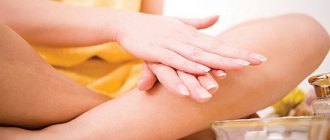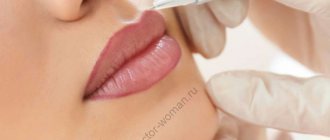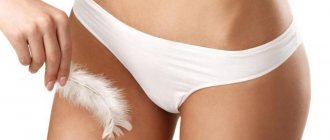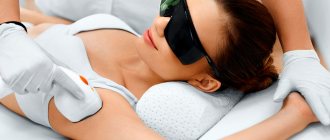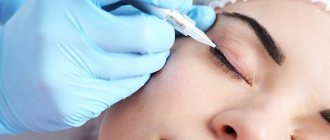In the modern world, there are many ways to deal with unwanted hair, and if you know about laser hair removal, then you have probably heard about photoepilation, the results of which are liked by many more than after using any other methods.
Let’s find out together whether this procedure is reliable and what to expect from it.
Brief description of the procedure
Photoepilation refers to one of the ways to combat unwanted body hair using high-frequency, high-intensity light pulses. During the process of hair shafts absorbing light energy, a number of different reactions occur in the subcutaneous tissues, the main of which is thermal.
Simply put, as a result of the procedure, the tissues are heated to high temperatures, which, in fact, causes the destruction of the hair follicle and the hair itself.
This is interesting !
From a scientific point of view, it is more correct to call photoepilation photothermolysis (“thermo” in translation means temperature, and “lysis” means destruction). The light waves emitted by the equipment have different intensities, which largely depends on the color of the hair, which, in turn, is directly related to the amount of melanin contained in the follicles. That is, the darker your hair, the more of this substance it contains.
In each individual case, specialists at the cosmetology center take this fact into account, using equipment for photoepilation
with a light wave that will be fully absorbed by melanin and will not have a strong effect on other skin pigments .
This selective effect is called “selective photothermolysis.”
In this case, the hairs are heated to 70-80°C, as a result of which all follicular cells die, in particular the hair papilla, so that their growth should no longer resume.
Considering the above data, a completely logical question arises: “Is photoepilation forever or not?” But first things first.
Adverse reactions
Undesirable consequences do not occur often. The cause is usually errors in setting up the device, hypersensitivity of the skin, or non-compliance with the rules of the procedure.
The following side effects are possible:
- burns and skin irritation;
- the appearance of an inflammatory rash;
- scarring of damaged skin areas;
- dysfunction of the sweat glands;
- formation of age spots;
- folliculitis.
There may be slight redness of the treated areas and dry skin. These phenomena usually go away on their own within a week. To speed up regeneration, use moisturizing and healing products on a non-greasy basis.
Exposure to light waves of insufficient length can provoke the opposite effect in the form of excessive hair growth in the area. In order to prevent the development of complications, you need to choose a competent specialist and properly prepare for hair photoepilation.
How many sessions will it take to completely remove hair?
Of course, not a single hardware hair removal procedure can bring 100% results in just one session , so when figuring out whether photoepilation is effective, this point should be taken into account.
Results after the first session
A full course of photoepilation involves 5-6 sessions with some time intervals between them (at least two weeks).
Nevertheless, the result of the procedure, that is, its effectiveness, is visible after the first procedure: you will forget for a long time about 30% of unwanted vegetation in the treated area. Important ! Immediately after the procedure (during the first days), you may not notice significant changes, since during photoepilation only the vascular sac is immediately destroyed, and for the hair to die, you still need to wait (usually from 3 to 7 days).
Result after a course of procedures
After completing the photoepilation course, you will forget about the appearance of hair in the treated area for a long time. The skin becomes soft and smooth, maintaining this condition for quite a long time. If you are tormented by doubts and do not know whether photoepilation is worth doing, then considering the end result, perhaps you should answer in the affirmative.
For more information about the most important aspects of photoepilation and the effectiveness of the method, watch the video:
Skin care recommendations
Once the epilation process is complete, the affected skin will require special care. If you follow a number of simple recommendations, the area being epilated will not be damaged, and the hair will disappear faster.
- Immediately after completing IPL procedures (especially after removing facial hair), it is necessary to lubricate the area well with a nourishing sunscreen cream, preferably with a hypoallergenic effect.
- Drink enough fluid – about 2–2.5 liters (required to speed up metabolic processes and nourish the epidermis).
- Do not expose the treated areas of the skin (especially the bikini area) to thermal, chemical or physical influences for 24 hours.
- You cannot stay in the sun for a long time or visit a solarium during the entire hair removal course.
- The remaining hair should fall off on its own, so it is better not to touch it or use hair removal products.
- You should refrain from water treatments (no hot bath, sauna, steam bath), maximum, a shower is allowed.
- Agree to the procedure, taking into account contraindications.
All clients are given recommendations that have a positive effect on the condition of the skin and the body as a whole after the manipulations. Thanks to this care, it is saturated with nutrients, and the possibility of adverse reactions in the form of pigmentation or scars disappears. However, if you do not follow the recommendations, the effectiveness of ipl hair removal is reduced several times.
How effective is photoepilation?
The effectiveness of any procedure largely depends not only on the actions of the cosmetologist, but also on a number of other factors (for example, hormonal levels or individual characteristics of the skin and hair). Therefore, it is, of course, impossible to unequivocally answer the question about the success of the procedure and its duration. Let's find out the most common reasons for fairly rare failures.
Why does hair grow after photoepilation?
Despite the fact that many experts talk about a 100% guarantee of getting rid of unwanted hair using photoepilation, it is not always possible to achieve such a result.
The first and most important reason why hair does not fall out after photoepilation is the small amount or complete absence of melanin in the hairs, which means that this technique cannot help a person completely get rid of excess hair. However, this is not the only problem in this case.
Very rarely, after the first course of the procedure, the hair disappears forever, and in most cases this is due to the fact that the sessions do not always coincide with the active phases of hair growth, and for the success of the business they are needed (otherwise the bulb will remain “living”).
In addition, hair follicles have the ability to regenerate, and if the follicle was partially destroyed, then most likely this will happen. A hormonal imbalance in the body (for example, due to pregnancy) can negate all achieved results.
The fact that hair has completely stopped growing after photoepilation is more often said by people who underwent the procedure on a small area of the body - under the armpits or, for example, removed facial hair. If you removed hair from all your legs, then most likely, in a few years the procedure will have to be repeated. But even in this case, the regrown hair will no longer be as noticeable as before.
How long does it take for hair to grow after the procedure?
If we talk about the effectiveness of photoepilation in digital equivalent, then statistics indicate a guaranteed period without hair from six months to five years .
Information !
After the procedure, hair on the limbs takes much longer to grow than on the face, where usually the course of photoepilation must be repeated after 7-8 months. What does this duration of the effect depend on? We have already mentioned the qualifications of the cosmetologist and the individual characteristics of each client, but in addition to this, there are several more factors.
These include the correct determination of the required light wave power and the depth of its penetration, as well as the level of modernity of equipment for photoepilation. Do not forget that the thicker and darker the hair being removed, the easier it will be to deal with it. At the same time, removing very light and gray hair will require more sessions.
Adverse effects of photoepilation and ways to combat them
The photoepilation procedure must be carried out by a highly qualified specialist in the field of hardware cosmetology. High-quality equipment and how the client cares for the skin after the session also play an important role. Adverse consequences of photoepilation usually arise precisely because of non-compliance with these rules, but sometimes an unpredictable individual reaction of the body also occurs.
The occurrence of burns after photoepilation
Unfortunately, thermal burns of the skin during photoepilation procedures are not uncommon.
Thermal burn and subsequent hyperpigmentation are common side effects of photoepilation.
The most common reasons for epidermal burns are:
- failure to comply with the preparatory stage on the part of the client. Two weeks before the photoepilation session, you should not visit the beach or solarium, or use cosmetic products with a self-tanning effect. If the concentration of melanin pigment in the skin increases, then the light beam of the photoepilation device penetrates too deeply, unevenly heating the area near the hair follicle;
- incorrect preparation for a photoepilation session by a cosmetologist. Before working with the device, the cosmetologist must make sure that the client has no contraindications to the procedure. It is also highly advisable to perform a trial treatment of a small area of skin to identify individual intolerance;
- using a faulty device or failure to follow the operating procedure. Before visiting a beauty salon, you need to make sure that the hardware hair removal specialist has successful experience. It is best to ask the administration for the license of the specific cosmetologist you are going to visit. If the specialist incorrectly selects the parameters of the light pulse, the client may receive a deep thermal burn during the procedure.
Also ask the administration of the beauty salon when special lamps emitting non-monochromatic light were changed in the photoepilation apparatus. If these lamps are not replaced promptly, the risk of thermal burns increases.
Standard guidelines for the treatment of thermal burns
As soon as you feel that a strong burning sensation appears on the treated area of the epidermis, and after a few minutes the skin turns intensely red, the photoepilation procedure should be stopped immediately.
With a severe thermal burn of the epidermis, the skin swells and becomes markedly red.
The burn site should be cooled as quickly as possible. For this, cold running water or a special cooling gel is suitable, which the cosmetologist who performed the photoepilation procedure should have. At home you can use Panthenol spray.
In case of serious burns, under no circumstances should you:
- self-medicate and apply food products to the affected surface, as is often recommended in traditional medicine recipes;
- disrupt the integrity of blisters filled with liquid;
- apply fatty creams or oil to damaged skin.
In any case, you need to see a dermatologist and carefully follow the recommendations received until complete recovery.
The appearance of acne on the skin after a photoepilation session
Sometimes after the photoepilation procedure, minor inflammatory processes occur on the surface of the treated area of skin.
Some pimples that appear after photoepilation may be filled with pus
Pimples and inflamed swellings occur most often due to the following reasons:
- extremely high skin sensitivity to external influences;
- clogging of the hair pocket;
- failure to comply with hygiene standards during and after the procedure;
- hormonal imbalance in a woman’s body;
- unpredictable allergic reaction (accompanied by swelling and itching);
- penetration of harmful microorganisms due to violation of the integrity of the skin.
Comparison with other hair removal methods
We have already figured out a little about the features of photoepilation, but this is far from the only modern method of getting rid of unwanted hair, so it will be interesting to find out how much it is enough in comparison with other methods of getting rid of unwanted hair.
How long does it take for hair to grow after sugaring?
An equally interesting and popular technique today is sugar hair removal or sugaring, which is gaining more and more popularity almost every day.
Its essence lies in applying a special paste based on a caramel mixture of sugar to the area to be epilated. Many women note the high effectiveness of this method, but no matter how hard you try, the result of photoepilation will last longer (the effect of sugaring is observed for no more than 3-4 weeks). This is interesting ! The tradition of sugar hair removal as the main method for removing unwanted hair from the body dates back to Ancient Egypt, Greece and Mesopotamia. The writings of those times noted that kings insistently demanded only “pure and smooth” women.
After waxing and wax strips
Until recently, the use of wax depilation, as well as the use of wax strips, was considered the most optimal option for solving the problem of excess hair. Many women probably know how easily and quickly hair can be removed after waxing, but the painfulness of the method puts it one step lower than photoepilation.
In addition, the smoothness and silkiness of the skin in this case remains much shorter, only 2-3 weeks. In fact, waxing and sugaring are at approximately the same level in terms of effectiveness, and the main difference is in the direction of hair removal: in the first case, hairs are removed against their growth, and in the second, along the direction of growth.
After laser hair removal
Laser hair removal is closest to photoepilation in terms of the specific action, although the latter is considered a more reliable method of hair removal due to the intense level of exposure.
Most experts claim the possibility of completely getting rid of unwanted vegetation for up to five years or more. Read more about how long laser hair removal lasts and how long hair does not grow.
Nevertheless, most often, to consolidate the effect, you have to repeat the course after 1-2 years, but in comparison with the above methods, laser hair removal can be considered the most successful option (hair grows quite often after photoepilation).
After depilatory cream
Depilatory cream is perhaps the most unreliable way to combat unwanted hair (again, in comparison with the above options).
Most of those who have used it (based on information on women's forums) note the low effectiveness of such creams, since the hair becomes noticeable again within a week after use. That is, even the most expensive and well-known products of this kind are not even close to photoepilation. Although, to be fair, it is worth noting the advantage of using depilatory cream compared to regular shaving.
After the epilator
When understanding how long hair does not grow back after different methods of removing it, it is worth remembering the possibility of using a regular epilator. Like a depilatory cream, this device is not able to provide long-lasting smoothness and silkiness to your skin, despite the fact that many videos assure you otherwise.
No matter how high-quality the purchased epilator is, it will only be able to remove hair that is on the surface of the skin, and the rest that has begun to form will calmly appear in a few days. Therefore, ideally, hair removal will have to be done every week.
Contraindications to the procedure
Comparing how long hair does not grow after different methods of hair removal, it is easy to notice that laser and photoepilation are the most effective options. However, in both cases there are a number of contraindications that can stand in the way of obtaining smooth and soft skin.
In particular, these include:
- acute allergic reactions;
- chronic diseases during exacerbation (for example, psoriasis, lichen, atopic dermatitis, eczema, scleroderma, lupus erythematosus, vasculitis, etc.);
- hypertension and coronary heart disease;
- exacerbation of herpes;
- phlebeurysm;
- malignant tumors and neoplasms on the skin in the epilated area;
- infectious diseases in the acute phase;
- helminthiasis, dermatozonosis and other parasitic diseases;
- During pregnancy and breastfeeding.
In any of these cases, the procedure will have to be postponed.

